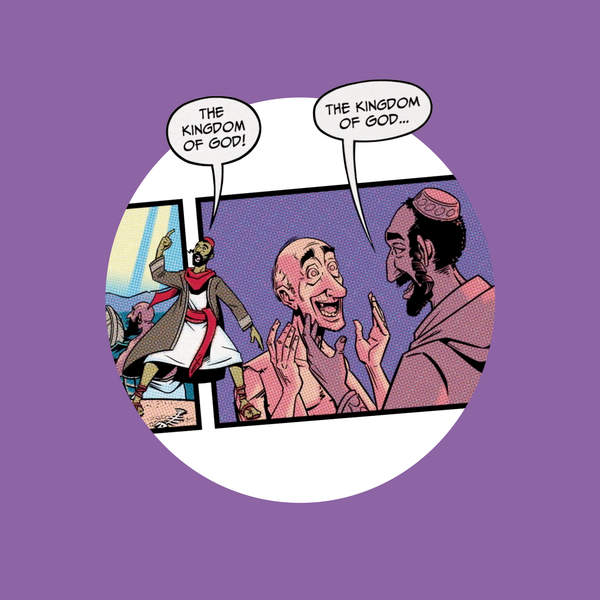
Chaotic Waters
Episode Chapters
Show Notes
In part one (00:00 - 25:35), Jon reviews the image of the ideal state of humanity and postulates it as a garden mountain fortress. He asks Tim why this is so different from a more familiar one of a heaven full of clouds and angels. Tim says that it’s important not to mistake the image of a metaphor for the reality of what the image points to. Tim also quotes TS Eliot saying that poetry is a “raid on the inarticulate.” In other words, poetry is meant to describe things that can’t be described in normal, factual use of language. Tim begins to outline the use of the metaphor of chaotic water in the Bible. Chaotic water is the first image given in the Bible. It’s meant to convey a state of un-creation, a state that is uninhabitable and unwelcoming of life. Tim begins to contrast the dark chaotic water that is present at the start of Genesis with the river of life that flows through Eden and is created later in the creation story. In part two (25:35 - 40:25), Tim explains that chaotic waters often become personified as evil. For example, in the story of the Exodus, Pharoah and his army is made equivalent to the chaotic waters in Exodus 15. This story runs in parallel with Psalm 18. "O Lord God of hosts, who is like You, O mighty Lord? Your faithfulness also surrounds You. You rule the swelling of the sea; When its waves rise, You still them. You Yourself crushed Rahab like one who is slain; You scattered Your enemies with Your mighty arm." (Rahab is a Hebrew word for Egypt). In part three (40:25 - 52:25), Tim outlines Isaiah 17:12-14. 12 Woe to the many nations that rage— they rage like the raging sea! Woe to the peoples who roar— they roar like the roaring of great waters! 13 Although the peoples roar like the roar of surging waters, when he rebukes them they flee far away, driven before the wind like chaff on the hills, like tumbleweed before a gale. 14 In the evening, sudden terror! Before the morning, they are gone! This is the portion of those who loot us, the lot of those who plunder us. The metaphor of chaotic waters further expands to equate the warring nations with chaotic waters. Then Tim begins to outline the new creation prophecies and their relation to the chaotic water metaphor. Joel 4:18: 18 And in that day The mountains will drip with sweet wine, And the hills will flow with milk, And all the brooks of Judah will flow with water; And a spring will go out from the house of the Lord To water the valley of Shittim. Zechariah 14:6-9: 6 On that day there will be neither sunlight nor cold, frosty darkness. 7 It will be a unique day, known only to the Lord with no distinction between day and night. When evening comes, there will be light. 8 On that day living water will flow out from Jerusalem, half of it east to the Dead Sea and half of it west to the Mediterranean Sea, in summer and in winter. 9 The Lord will be king over the whole earth. On that day there will be one Lord, and his name the only name. Isaiah 2:1-4: 2 Now it will come about that In the last days The mountain of the house of the Lord Will be established as the chief of the mountains, And will be raised above the hills; And all the nations will stream [lit. “river”] to it…. 3 And they will hammer their swords into plowshares and their spears into pruning hooks. Nation will not lift up sword against nation, And never again will they learn war. He says that new creation means the restoration of the cosmic mountain and the reunification of the waters. In part four (52:25 - 57:35), the guys try to crystalize their thought process. Danger and death in the Bible are described as chaotic waters and love, peace and security are described as a river of life. Tim says these images are fundamental to understanding the Bible, especially the prophets. In part five (57:35 - end), the guys recap their conversation on metaphor and talk briefly about creating the video on metaphors in the Bible. Tim briefly touches on the story of Jesus walking on the water. Why is this story in all the gospels? Because in the Jewish tradition, it represents Christ’s command over the chaotic waters that threaten human life and originally appear in Genesis 1. Thank you to all our supporters! Next week we will have a Poetry and Metaphor Q+R episode. Send us your questions at info@jointhebibleproject.com by June 25th!
Show Produced By:
Dan Gummel, Jon Collins
Scripture References
Referenced Resources
- "More Than Cool Reason: A Field Guide to Poetic Metaphor" by George Lakoff and Mark Turner
- "Metaphors We Live By" by George Lakoff and Mark Turner
Interested in learning more? Check out Tim's library for a list of recommended books and other resources.
Get the BibleProject app for access to our entire library of resources in one place.
